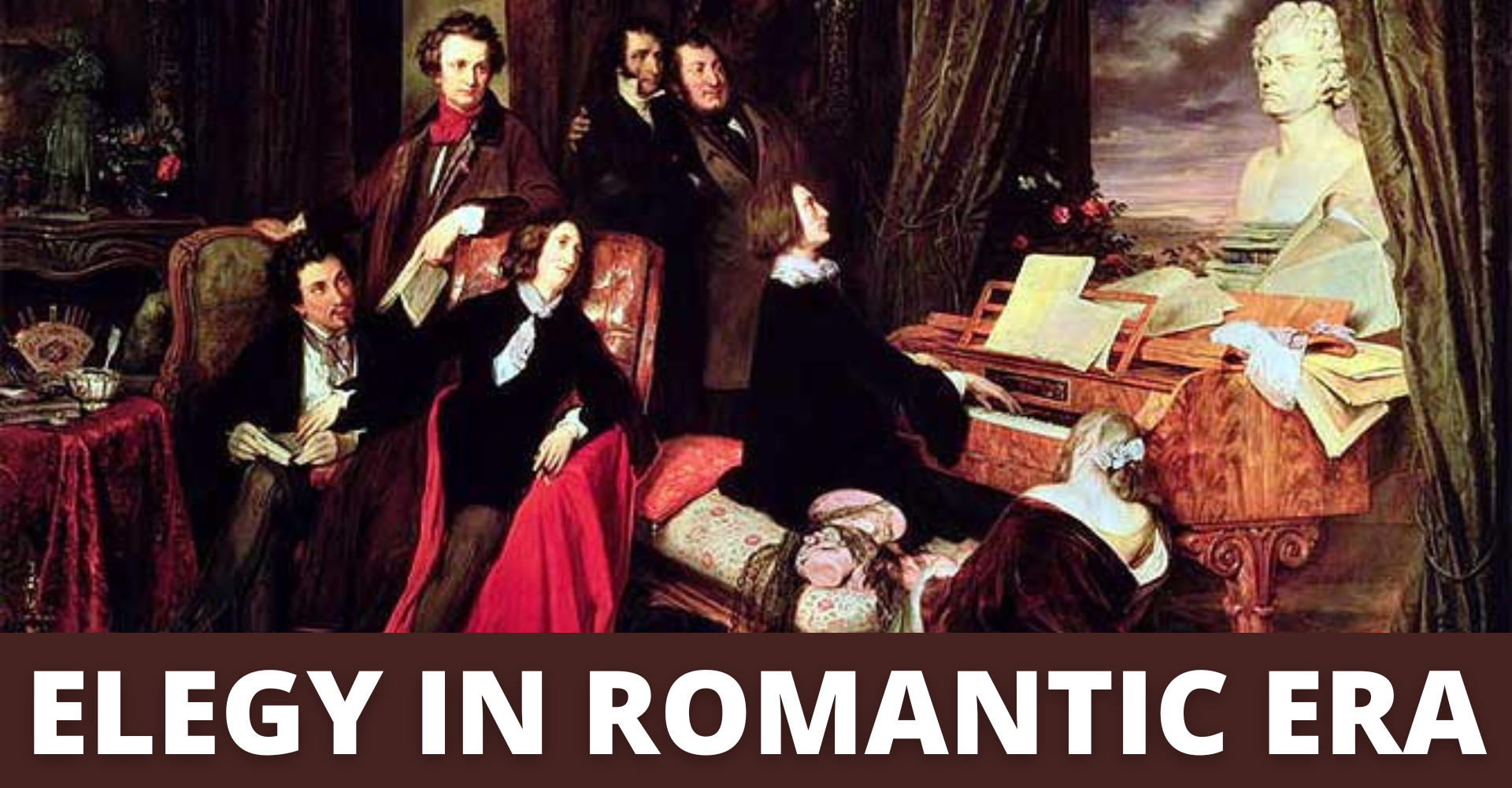ELEGY IN THE ROMANTIC ERA :
Pessimistic or elegiac note runs through all pre-romantic and romantic poetry, with the solitary exception of Wordsworth. Even when not writing an elegy, these poets pour out their suffering and frustrations in their poetry, till their poems tend to be laments on themselves or on their age. They are elegiac in tone, though they are not in the elegiac connection. However, P.B. Shelley mourns the death of Keats in his famous elegy Adonais written in the pastoral convention. Shelley was not very intimate with Keats and we learn more from it about Shelley than about Keats. As a pastoral elegy. Adonais closely Shelley than about Keats. As a pastoral elegy, Adonais closely follows the classical machinery of the pastoral. It may be divided into two parts. The first running up to the 38th stanza, is cast in the pastoral mould; there is the traditional invocation to weep, Sympathetic mourning in nature, procession of mourners consisting of the flocks of the dead shepherd, and his fellow shepherds, and personal digression and invective. In the second part, Shelley strikes a modern note. There is a change of mood, and final consolation. In the pastoral tradition, the dreams of Keats and the powers of nature are represented as mourning the death of Adonais. Then there is a fierce invective against those reviewers who were supposed to have his death and then in the end the poet finds hope and consolation in that death has made Keats immortal. He has become one with nature, and eternal like her.
It has been usual to compare Adonais with lets Lycidas. For one thing the pastoral note itself is weaker and thinner and less consistent in Adonais than in the case with Lycidas and Thyrsis. Milton represents himself as a shepherd mourning the death of another shepherd who was nursed along with them. “On the self-same hill, and who, fed the same flock of mountain shade and rill,” and the pastoral note is sustained from beginning to the end. But in Adonais the pastoral note is entirely absent from the first 8 stanzas, it is struck for the first time in the 9th stanza, continuous till the 17thstanza, and then ceases for the next twelve stanzas. It brings in again the 30th stanza, continues in a magnificent vein for six stanzas and then dies out altogether.
In the second part of the poem, the note of sorrow changes to one of hope and joy. But the change is not abrupt : it is gradual and the two parts have been artistically blended into a single whole. The transition takes place is in the 38th stanza. The readers are asked not to mourn the death of Adonais who, “wakes or sleeps with the enduring dead.” His pure spirit has become a part of the eternal. This thought reminds us of, “Naught we know dies”, of the 20th stanza. In this way the two parts run into each other and artistic unity of the whole is maintained. Upto now Shelley had been closely following his Greek models, but now he breaks free from their influence. In this respect, too, Milton had led the way : he had also consoled himself with the thought that the soul of his friend had gone to heaven. Says Edmunds, “Like Milton, Shelley was inspired by the Greek models, and again like Milton, he transmuted the ancient form into a magnificent modern poem . And as the death of Lycidas let Milton up to the triumphant Puritanism which was the highest spiritual force of his time, so Shelley emerges from his sorrow into a Pagan of immortality, the victory-song of love, where in death is swallowed up in Life.
THE VICTORIAN ELEGY : “In Memoriam” :
It was in the Victorian era that, for the first time, conscious pessimism became a force in English literature. Most of the poetry of the period is elegiac in tone. It is usual to mourn the death of some prominent person, of some friend or relative, of some acquaintance, or even that of some pet animal. However, two great poets tower head and shoulders above others in the field. They are Tennyson and Mathew. The elegiac note looms large in the poetry of Tennyson and his In Memoriam is the greatest of elegies in the English language. It was inspired by death of the poet’s intimate friend Arthur Hallam, and as its title indicates was written in his memory and it immortalises that memory. But In Memoriam would not be a great work of art, if it were merely the embodiment of personal grief in fact. In Memoriam is much more than that : it is also an expression of the poet’s reflections on God, nature, soul and the mystery of life and death. It also expresses the doubts and uncertainties of the age. Indeed, the best and most lyrical passages in the elegy are those where the poet becomes the conscience and voice of the age and gives poetic expressions to its spiritual troubles.
Considered as an elegy. In Memoriam has several points of contact with the other great English elegies. In each of the three great elegies Lycidas, Adonais and Thyrisis as also in In Memoriam, the poet mourns the loss of some dear friend, who died young and who was a youth of great promise. In each case the poet begin with mourning the loss of his dear friend, but soon passes on to a condemnation of some social abuse or evil, and then indulges in sad reflections on the mystery of life and death, and the fate of mankind. In each case the poet does not mourn alone, but he has a number of fellow mourners who mourn with him. Then finally, in each of these elegies, the poet moves on from grief and despair to hope for the future, and may even strikes a note of joy. Thus Tennyson ends with the faith in the “one far off divine event”, to which the whole creation moves. He is confident that he would be united with his friend in the life after death.
However, the distinctive nature of In Memoriam and its real greatness are thrown into sharp relief by the differences between Tennyson’s elegy, and other elegies. While the other three elegies are in the pastoral convention and the poets mourn their loss in the guise of shepherds mourning the death of another shepherd. Tennyson does not follow the pastoral convention. He mourns in his own person, his expression of grief is direct and so it is more poignant and effective. It has a greater ring of sincerity. Not only in Tennyson’s Grief more intense and poignant, it is also deeper and more lasting. It lasts for over 17 years, while the grief if the other three poets is of a much shorter duration. “The passage of time does not weaken the poet’s grief. It only grows clamber, but deeper than that of the other elegies. It is much longer, it consists of 131 elegiac lyrics carefully arranged to form an integrated whole.”
Not only is In Memoriam superior as an expression of grief, it is super in another respect also. As Percival points out, “besides the elegy, then runs a theology.” It is an expression of the poet’s view of God. Name immortality of the soul, and the mystery of life and death. It traces the movement of the soul from grief and despair, through the conquest of that despair, ultimate hope and joy. It is a record of Tennyson’s spiritual troubles, and as him spiritual troubles are also those of his age. In memoriam is a valuable social document, a faithful record of the doubts and uncertainties, hopes and aspirations, of the times in which it was written. Evolutionary science had given a knock-out blow to the traditional theories of creation, and faith both in God and Nature was shaken. In memoriam reflects this loss of faith. God is merciful and if he has a holy plan, why is there so much of sufferings, such brutal struggle for existence, and pain and death? Thus in Tennyson’s breast, and in the age, there was a conflict between science and religion, God’s omnipotence and his love were hard to reconcile with the fact of suffering. Tennyson’s plea is for a compromise between science and religion, and he stresses that such a conciliation can be possibly only through faith, and not through knowledge. The best and the most lyrical parts of In Memoriam are those in which he becomes the voice of the human race and deals with problems which exercised his age, and which have always exercised mankind. In short, “In Memoriam is a epitome of its age, which the other elegies are not. In this respect, Tennyson’s elegy stands along in the whole range of English literature.”











